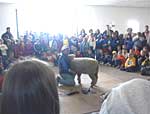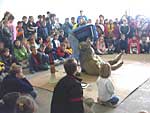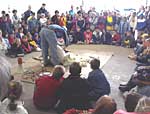
[Bob
Phares raises corn, soybeans and some cows.
He showed students a tractor with a ripper attachment.
Farmers use rippers in the fall to fracture dry, compacted
soil so that rain and fertilizer can flow into the ground.]
|

[Lynn
Haseley uses this combine to harvest corn and soybeans.
He explained to listeners how this piece of equipment cuts
crops and separates food from waste.
This model costs $175,000óa larger one might cost
$225,000!]
|
|

[Local
farmer Bill Sahs explains to a student how this brand-new Kinze
planter works. Invented
around 1976, the attachment cuts the earth, drops one seed and
insecticide into the ground, and seals up the hole.]
|

[Sahs
also explained that the tractor has four rear tires to distribute
the tractorís weight and therefore reduce soil compaction.]
|

[Before
shearing his sheep, Steve described how and why farmers cut off a
lambís tail. He
explained that professional shearers can shave a sheep in two or
three minutes.]
|

|

|

|
|
[The
students gasped as Steve plopped his sheep over and started to
shear. Several
students asked their teachers if he was hurting the sheep.
The audience learned that one pound of wool makes 20 miles
of yarn, and each sheep yields 6 to 8 pounds of wool with each
cut. One student
asked how quickly a sheepís coat grows.
Steve answered by saying that sheep are sheared once or
twice a year. He commented that because the price of wool is so low right
now, itís only worth it for farmers to shear their sheep once a
year.]
|
|
Back
to top
|
News
| Sports
| Business
| Rural
Review | Teaching
& Learning | Home
and Family | Obituaries
Community | Perspectives | Law
& Courts | Leisure Time | Spiritual
Life | Health
& Fitness | Letters
to the Editor
|